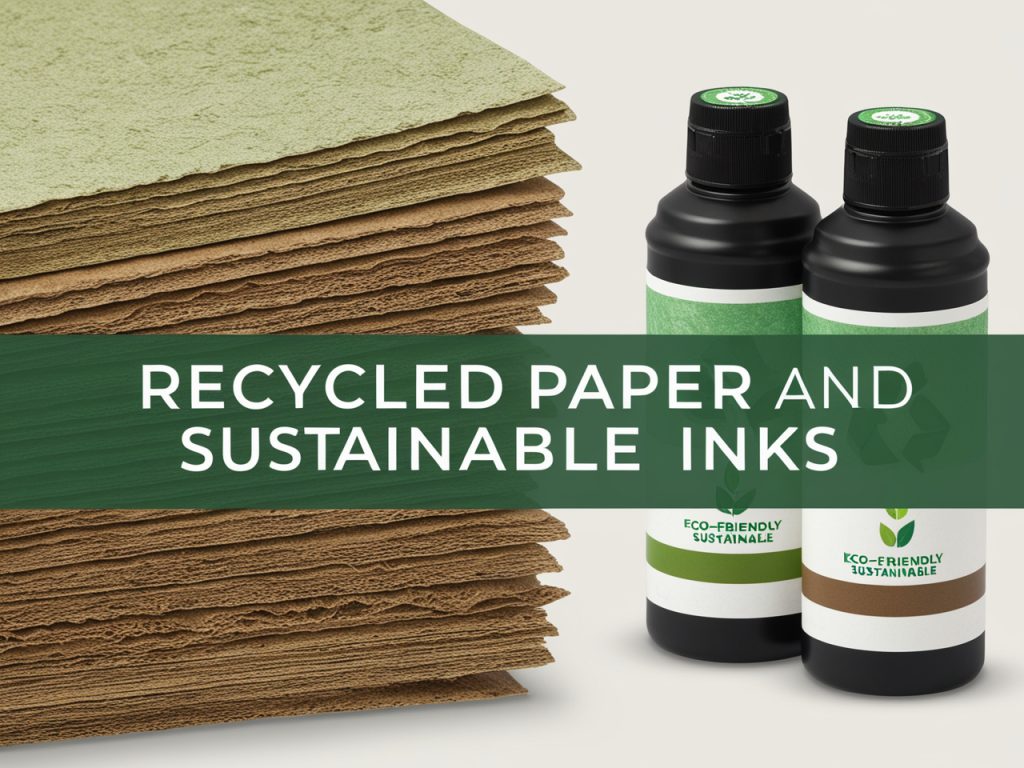
As sustainability becomes a top priority for businesses and consumers alike, using recycled paper and sustainable inks in printing projects is an effective way to reduce your environmental footprint. By choosing these eco-friendly materials, you contribute to conserving natural resources, reducing pollution, and promoting a circular economy. This guide explores the benefits of recycled paper and sustainable inks, the types available, and how to integrate them into your print projects.
1. Recycled Paper: What You Need to Know #
Recycled paper is produced from post-consumer waste, meaning it is made from previously used paper products that have been collected, processed, and repurposed. This reduces the need for virgin materials, such as wood pulp, and helps lower the demand for deforestation.
1.1 Types of Recycled Paper #
There are different levels of recycled content in paper products, which are usually expressed as a percentage. Here are the most common types:
- 100% Recycled Paper: This paper is made entirely from post-consumer or pre-consumer waste and is the most environmentally friendly option. It typically has a natural look and feel but is available in different finishes.
- Partially Recycled Paper: This paper contains a blend of recycled fibers (e.g., 30%, 50%, or 80%) mixed with virgin fibers. The percentage indicates how much of the paper is made from recycled content.
- FSC-Certified Paper: Paper that is FSC (Forest Stewardship Council) certified is sourced from responsibly managed forests. FSC-certified recycled paper combines post-consumer waste with sustainable virgin fibers.
1.2 Benefits of Recycled Paper #
- Reduces Deforestation: Using recycled paper minimizes the demand for virgin paper, helping to preserve forests and biodiversity.
- Conserves Resources: Recycling paper uses less water and energy than producing new paper from raw materials, which significantly lowers the overall environmental impact.
- Reduces Landfill Waste: By recycling post-consumer waste, paper that would otherwise end up in landfills is given a second life, helping to reduce waste and pollution.
- Promotes Circular Economy: Using recycled paper supports the recycling industry and encourages the reuse of materials, contributing to a more sustainable and circular economy.
1.3 Applications of Recycled Paper #
Recycled paper can be used in a wide range of printing projects, including:
- Business Cards: Choose 100% recycled or FSC-certified paper to give your cards an eco-friendly appeal.
- Brochures and Flyers: Use partially recycled paper for a professional finish while maintaining sustainability.
- Packaging: Recycled paper is ideal for eco-conscious brands that want to use sustainable packaging materials.
- Letterheads and Stationery: Opt for recycled paper for company stationery to align with your brand’s environmental goals.
1.4 Paper Quality Considerations #
Some people may worry that recycled paper is of lower quality than virgin paper. However, advancements in technology mean that recycled paper can be just as high-quality, offering the same durability, smoothness, and printability as non-recycled paper. You can find recycled paper in various finishes, including gloss, matte, and uncoated, to suit your specific needs.
2. Sustainable Inks: An Eco-Friendly Alternative #
Traditional inks are often petroleum-based, containing harmful chemicals and solvents that release volatile organic compounds (VOCs) into the atmosphere, contributing to air pollution and environmental degradation. Sustainable inks provide a greener alternative, made from renewable resources that are less toxic and environmentally harmful.
2.1 Types of Sustainable Inks #
Here are the most popular types of eco-friendly inks used in printing:
- Vegetable-Based Inks: These inks are derived from renewable vegetable oils, such as soybean, linseed, or corn oil, rather than petroleum. They have lower VOC emissions and are biodegradable, making them a popular choice for sustainable printing.
- Soy-Based Inks: A type of vegetable-based ink, soy ink is one of the most widely used sustainable inks. It produces vibrant colors, is easier to de-ink during the recycling process, and has a lower environmental impact than traditional inks.
- Water-Based Inks: Water-based inks use water as their primary solvent, eliminating the need for harmful chemicals. They are non-toxic, safe for the environment, and ideal for projects where eco-friendliness is a top priority.
- UV-Curable Inks: While not entirely plant-based, UV-curable inks harden instantly when exposed to UV light, reducing VOC emissions. They are ideal for printing on non-porous materials, like plastic or glass, and result in less overall waste.
2.2 Benefits of Sustainable Inks #
- Lower VOC Emissions: Sustainable inks release fewer VOCs into the air, reducing the environmental and health risks associated with air pollution.
- Renewable and Biodegradable: Many sustainable inks are made from renewable resources, such as plants, and are biodegradable, reducing their long-term impact on the environment.
- Better for Recycling: Inks like soy-based ink are easier to remove from paper during the recycling process, improving the recyclability of printed materials.
- High-Quality Results: Despite their eco-friendly nature, sustainable inks produce vibrant, sharp, and long-lasting prints, making them a suitable replacement for traditional inks.
2.3 Applications of Sustainable Inks #
Sustainable inks can be used in virtually all printing projects, including:
- Business Cards: Pair sustainable inks with recycled paper for an eco-friendly business card.
- Brochures and Marketing Materials: Choose vegetable- or water-based inks for brochures, flyers, and other marketing materials to demonstrate your commitment to sustainability.
- Labels and Packaging: Sustainable inks work well on labels and packaging, especially when paired with recycled or biodegradable materials.
- Product Catalogs: Use soy or water-based inks to produce high-quality, eco-friendly product catalogs.
3. Combining Recycled Paper and Sustainable Inks for Maximum Impact #
To maximize your eco-friendly printing efforts, combine recycled paper with sustainable inks. This powerful combination significantly reduces the environmental impact of your print materials and sends a strong message about your commitment to sustainability. Here are some tips for optimizing your print projects:
3.1 Match the Paper to the Project #
Choose the right type of recycled paper for your project. For instance, 100% recycled paper may be ideal for internal documents or eco-conscious branding, while partially recycled paper with a gloss finish might work better for high-end marketing materials.
3.2 Select the Right Ink #
Use vegetable- or water-based inks for most projects, especially if you’re printing on recycled or biodegradable materials. Soy-based inks are perfect for vibrant colors and clear text, while water-based inks are ideal for eco-friendly packaging or projects that prioritize environmental safety.
3.3 Go for a Minimalist Design #
Adopting a minimalist design approach can reduce ink usage, which in turn lowers the environmental impact of your print project. Avoid full-bleed designs, use fewer colors, and focus on clean, simple layouts.
3.4 Educate Your Audience #
Let your customers know about your eco-friendly printing choices. Include a small note or symbol on your materials stating that they were printed on recycled paper with sustainable inks, reinforcing your brand’s commitment to environmental responsibility.
4. Certifications to Look For #
When choosing recycled paper and sustainable inks, look for these certifications to ensure that the products you’re using meet high environmental standards:
- FSC (Forest Stewardship Council) Certification: Indicates that the paper was sourced from responsibly managed forests, ensuring sustainability and environmental protection.
- Green Seal Certification: This certification ensures that both the paper and inks meet strict environmental standards, from reduced chemical use to lower waste.
- SoySeal: A label found on products printed with soy-based inks, ensuring that the ink is derived from renewable resources and environmentally friendly.
5. Benefits for Your Brand #
Adopting eco-friendly printing practices not only helps the environment but can also enhance your brand’s image. Today’s consumers are increasingly drawn to brands that demonstrate a commitment to sustainability, and using recycled paper and sustainable inks is a visible, tangible way to show that your company cares about its environmental impact.
Positive Brand Perception #
By choosing sustainable materials, your business can appeal to eco-conscious consumers, showcasing that your values align with the growing demand for greener products.
Competitive Advantage #
Brands that invest in sustainable printing can differentiate themselves from competitors who haven’t yet made the switch, helping to attract customers who prioritize eco-friendly practices.
Long-Term Cost Savings #
While recycled paper and sustainable inks may sometimes have a slightly higher upfront cost, they contribute to long-term sustainability goals and can help reduce waste, energy use, and environmental damage, ultimately saving costs in waste management and resource usage.
Conclusion #
Using recycled paper and sustainable inks is an effective way to reduce your environmental footprint while maintaining high-quality printing standards. Whether you’re producing business cards, brochures, packaging, or promotional materials, opting for eco-friendly materials demonstrates your commitment to sustainability and appeals to today’s eco-conscious consumers. By making small changes to your printing practices, you can have a positive impact on the environment and strengthen your brand’s reputation.
You can find free business card templates on Freepik.
Learn more about the different printing methods in this comprehensive guide.

